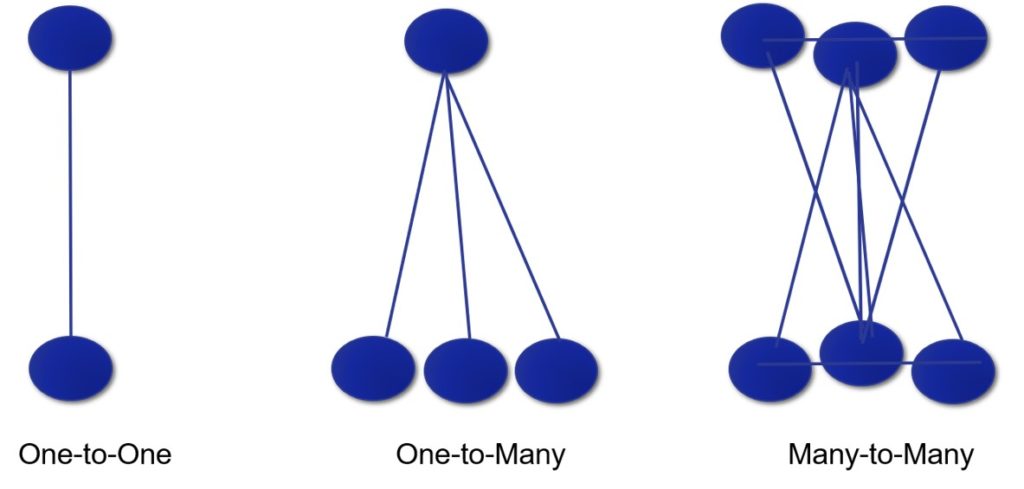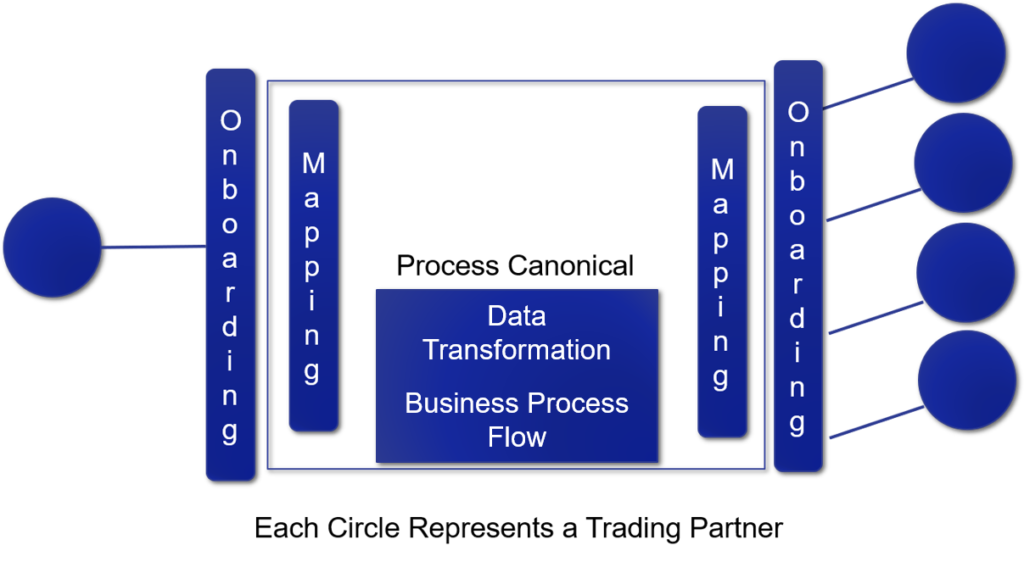Across from me, sits an empty chair.
In fact, sadly, there are many empty chairs in the room. Five people canceled at the last minute due to travel restrictions.
Today, I am facilitating the Network of Networks share group in Antwerp. The reason the seats are empty? While all supply chain leaders are interested in the topic of building value networks, only a few companies are actively investing in building data architectures to enable the extended supply chain. As a result, while there is a desire to learn, the interest is higher than plans to execute. Here I want to share my perspective after three years of facilitating the group.
People come and go in the group based on company dynamics. The network of networks share group has included manufacturers like BASF, Berry Plastics, Dow, Grace, Evonik, Intel, MARS, P&G, and Schneider Electric. Through the effort, I have learned a lot. I give thanks for the experience.
Let’s Start with a Bit of History
The words end-to-end supply chain easily rolls off the tongues of supply chain leaders. The definitions are usually different. Where efforts start and end vary…
The visions are more far-reaching than the execution. While companies articulate the words end-to-end, the focus is usually on executing a four-wall strategy. Technology and process innovation ends at the doorstep of the enterprise. The goal is an efficient enterprise. The problem? Today, an efficient enterprise is not sufficient.
In contrast, my vision of end-to-end is a supply chain that operates seamless and bi-directionally from the customer’s customer to the supplier’s supplier crossing over the processes of sell, plan, source, make and deliver. My goal with the group is to make this a reality. There are many obstacles:
- Focus. Current IT investments are four-wall centric. ERP upgrades are sucking up the energy of the enterprise. Unfortunately, ERP is an enterprise platform that is not suitable as a value-chain connector. Companies are so busy working on ERP that there are no resources or monies to tackle building value networks. After all, an organization just has so many hours in the day. As a result, ERP investments are an opportunity cost for the company to drive innovation and build value networks.
- Confusion. Everyone uses the term network. Few ask what it means. When I was a Gartner analyst in 2001, there were over 120 B2b platforms. Then we termed them trading exchanges. Today, two decades later, only 10% of these initial start-ups survive. With the evolution of VANs, and trading exchanges at the turn of the decade, Electronic Data Interchange (EDI) became the workhorse of the industry to move data between companies. (EDI is an electronic interchange of business information using a standardized format; a process that allows one company to send information to another company electronically rather than with paper.) In an ideal state, trading partners work together to drive value in networks.
- Shifts in technology.. Business leaders use terms like business networks, supply chain operating network, value-added networks, portals, marketplaces, control towers, and network visibility interchangeably. However, they have very different definitions. The discussion becomes even more confused with the introduction of new technologies of blockchain, Internet of Things (IOT), and cognitive computing.
- Organizational capabilities to build value networks are low. One of the issues in building value networks is clear accountability. Within a typical organization, there is usually an EDI analyst in B2b commerce within IT, but there is seldom a supply chain leader driving capability building. These roles are far and few between. Even when there is a digital supply chain initiative, there is seldom a focus on building effective networks. As a result, the EDI analysts feel the pain but lack the power to drive improvements. Many are retiring…attempting to pass the baton, but struggling to find a replacement.
- Dance with shiny objects. Supply chain leaders love shiny objects. Process excellence is tough. Buying technology is easy. The market is fraught with technology vendors selling snake oil.
For over a decade, I have written about the building of value networks. My frustration? The focus today is continued investment in the traditional applications– legacy applications with those old-fashioned three-letter acronym names like ERP, CRM, APS, and SRM. This is an opportunity cost for 98% of companies. These legacy architectures are not effective connectors to drive value network interoperability.
Why Is This Investment Important?
So, if you are drinking your coffee, you might ask, “Why should I care?” The answer is threefold:
- Outsourcing increased. It is more important. Over the last decade, this increased by 15% in manufacturing and 25% in transportation. Without automation, these outsourced operations are islands. Data moves manually through spreadsheets and sneaker-net creating errors and introducing latency.
- Results. 95% of companies are stuck in driving improvement. The greatest opportunity for companies to drive down costs and improve inventory lies outside the four walls of the organization.
- Save the Planet. 92% of companies have a corporate social responsibility document, 65% of carbon and waste lie outside the four walls of the organization; yet, only 20% of companies take responsibility for the sustainability impact of their extended network.
 What Have I Learned?
What Have I Learned?
As I facilitated the Network of Networks group for the past three years, I learned:
Portals Are Ineffective. Many companies are investing in a dead-end street termed a portal. A portal assumes that a trading party has the time and energy to use a portal. The issue? Portals lack a system of record. As a result, as business conditions change, there is nothing to track the shifts. While a portal sounds like a good idea, it is not scalable. Many clients that I work with have over one hundred portals to view and work with. This is untenable.
Integration is the Wrong Goal. Focus On Interoperability and Synchronization. While most leaders will state the goal as the integrated end-to-end supply chain, the business requirement is synchronization (harmonization and reconciliation of master data, calendars, and rules). The goal is seamless interoperability between trading partners with minimal latency between technologies/systems. The discussions veer off track in a discussion of real-time data. Yes, speed is important, but the goal needs to be the delivery of information at the speed of business. Not all processes are real-time.
ERP is the Wrong Platform to Serve as a Connector. The data model for ERP is enterprise-centric and inside-out. As a result, it lacks the ability to model network activity and move outside-in signals bidirectionally. Value-chain solutions require secure multi-tier process enablement. By definition, this is not the role of ERP solutions.
Cloud Is An Enabler, but Cloud Providers Are Not Coming to the Party. Technology providers like Kinaxis and Oracle while championing cloud-based architectures are not building value network solutions. I am fiercely trying to recruit help from Google founders and Amazon. There is a need for new thinking.
Many SAPs. None Equal to the Mission. Each session that I facilitate usually includes off-hand comments about SAP Ariba. While I try to not let the group dwell on the gaps with the Ariba platform, the issues are painful for manufacturers. SAP ERP does not easily connect to SAP Ariba and the Ariba solution is problematic. The first and crippling issue is the architecture. The Ariba architecture, originally designed as a portal technology, is a barrier to driving bi-directional interoperability. It is clumsy and difficult.
ISO 8000 Standards Promising. Low-level of Industry Understanding. Banking operates seamlessly using a routing number and account information. Within supply chain management, there is no equal. The ISO-8000 master data standard for the company identifier is the ALEI. The ALEI is the authoritative legal entity. DUNs numbers and the GTIN are proxy identifiers.
In our work with a major manufacturer with 40 ERP systems, we found that despite the organization’s focus on managing company master data, that they had 30% over-lap on supplier numbers preventing clear accounting of price variance or tracking aggregate spend by a supplier for contract compliance. Switching to the ALEI ISO 8000 standard cured the issue. However, it is not easy. A large manufacturer that we work with has 293 ALEIs. The average company greater than 5B$ in revenue has more than 150 legal tax identities. Tax-efficient supply chain strategies in global corporations increased the number of legal entities make the tracking supplier master data more difficult. The reason? There are far more entities for invoicing and payment than most supply chain leaders realize. If only, it was as simple as banking.
Blockchain Not Ready for Prime Time. Even If It Was, the Business Process Is Not Ready. Blockchain technologies are advancing. The most common use cases are visibility within the enterprise across systems (like M&A), contract compliance using smart contracts to accelerate payment, lineage and track and trace (an example is tracking the cleaning of vessels like tank cars or sourcing coffee), and multi-party verification. In our testing, we find that blockchain is expensive and lacks scalability. However, if we fix the technical issues, the supply chain multi-tier process is not ready for blockchain. The issue? Blockchain requires the democratization of data and the sharing of data across parties. This requires trust. Unfortunately, despite decades of talk on collaboration, companies lack trust. They are not ready to validate data on an immutable ledger. Companies want to elongate payables not accelerate payment. Blockchain is part of the answer, but not a panacea to solving the issues of value chain architectures.
Venture Capital Makes the Market Riskier. In the past decade, the Value-added Networks (VANS) consolidated and Supply Chain Operating Networks received venture capital funding. Each investment weakened the technology market’s ability to respond to the need to deliver value chain architectures. To illustrate, let’s examine the investments.
In the Van market, IBM purchased Sterling Commerce, Opentext purchased GXS (after the acquisition of Inovis), and True Commerce purchased Datalliance. This consolidation slowed innovation.
In the Supply Chain Operating Network market, Thoma Bravo purchased Elemica and GHX slowing commercial efforts and awareness campaigns. In parallel, Insight Partners invested in E2open. Shortly after the investment in E2open, the Company went on a buying spree of enterprise applications. (These application purchases are a head-scratcher. The solutions don’t complement the E2open B2b platform and it is like a collection of misfit toys diverting the Company’s focus on interoperability.) Similarly, Infor purchased GT Nexus slowing market penetration.
For the buyer, it is a tough market to navigate and understand.
Dependency on Service Providers Slows Progress. Many companies have outsourced supplier onboarding, payables, and transportation management. The greater the outsourcing within a company, the larger the gap in current understanding of value networks and how to build capabilities. Service providers are not the answer to building value networks. Companies need to own their processes.
Interoperability Between Networks is Non-existent. There is no pathway forward to connect the existing supply chain operating networks. Each operates as an island. Companies will have to force GT Nexus to work with Elemica, Nulogy to One Network, E2open to Supplyon, and SAP Ariba to Exostar. There is no business incentive for the networks to work together to build interoperability. Why is this a problem? The current Supply Chain Operating Network strategy is an extension of functional processes. As a result, transportation managers buy transportation networks like GT Nexus or Descartes, procurement leaders buy procurement network capabilities from E2open and/or Ariba and manufacturing leaders seek contract manufacturing capabilities from Nulogy. There is no network that combines make, source and delivery capabilities in a consolidated network.
Similarly, the solutions are very industry specific. E2open evolved to facilitate sourcing for high-tech manufacturers while Elemica focused on chemical solutions and Exostar evolved to drive value for Aerospace and Defense. The network requirements vary by industry, but if we are going to build effective networks, we need to have solutions that embrace all industry sectors.
Network Definitions Confusing. Companies use terms like Value-Added Networks, Networks, and Supply Chain Operating Networks interchangeably. A Value-Added Network is typically used to describe an EDI provider. The connections are one-to-one.
 The value-added capabilities within a VAN are for mapping and onboarding and limited data transformation. Data moves by batch processing.
The value-added capabilities within a VAN are for mapping and onboarding and limited data transformation. Data moves by batch processing.
In contrast, a business network moves data for a specific purpose with limited data transformation. Examples include TraceGains and TraceLink for pharmaceutical serialization, 3PL and small parcel visibility solutions, and Elementum. The focus is on one-to-one connections and data movement. There is no data transformation.
The Supply Chain Operating Network shown below has stronger mapping capabilities. The focus is on data transformation using a multi-tier data model.

In a Supply Chain Operating Network, data moves more frequently than in a VAN that is crippled by batch processing/job overhead.
My Recommendation?
Take your seat at the table. Own your network. In the future, networks will compete against networks. Build a competitive advantage.
Minimize the dependency on outsourced services and invest in Supply Chain Operating Networks. Pressure the Supply Chain Operating Network providers to drive interoperability and build multi-tier processes between networks. Do this despite the fact that it does not fit their business models.
I am encouraging new players to enter the market. While I believe that I will die before SAP Ariba builds connectors to the market or GT Nexus aggressively builds interoperability with Elemica and other transportation providers, I think that the entrance of Amazon, Google, and Microsoft offers promise.
Use the ISO-8000 standards in supplier onboarding, item catalogs, and location descriptions. Cross-reference to the proxy identifiers of Duns, GS1, LEI, and other industry standards. Get involved.
Make solving this problem an organizational focus. Put a person in charge. Drive change by tackling the tough issues. Don’t get sidetracked by shiny objects. Do the hard work.
I hope this helps. I look forward to hearing more from you about your efforts.
We are currently tendering our tenth research study in this area to gain more insights. We would appreciate your help in filling out the survey. (Just click the link. All answers are shared anonymously.) Our goal is to share the research openly in the market to try to stimulate change. In this area, it is badly needed. Thanks in advance for your help.







